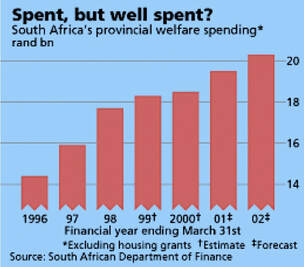While surfing the internet using “welfare state” as keywords, I have been amazed by how old this concept is in human society. It was the Indian emperor Ashoka who, three hundred years BC, first put forward the idea: he envisioned a society where the ultimate goal was “the wellbeing of human beings”. The idea was blended with religion and faith, where the driving forces were the dogmas of the era rather than laws and economic principles. Nevertheless, the emperor managed to set up “shady groves, wells, orchards and rest houses”, prohibit violence and promote equality: quite a remarkable achievement, I would say. Scrolling through the other results, I learned that more or less every other state experienced some kind of welfare state measure in history: from Europe to China, from Russia to the USA, from Australia to South America. But not Africa.
Certainly, this lack of reference is mainly due to the fact that in sub-Saharan Africa there were no states in the first place, at least before the eighteenth century. Recently, however, richer countries such as South Africa and Botswana have been working hard to fill the gap and poorer countries are trying to copy them. In Tanzania, almost 10% of the total population is enrolled in the Productive Social Safety Net (SNNP), the nation’s biggest welfare program which targets the poorest tranches of citizens. According to the scheme, recipients receive money just for being poor, but they can earn an extra if they perform tasks such as toiling on public projects or making sure that children attend schools. Ethiopia’s scheme requires participants to work, and it has been so popular that it is spreading everywhere in the country, reaching more and more people.
Certainly, this lack of reference is mainly due to the fact that in sub-Saharan Africa there were no states in the first place, at least before the eighteenth century. Recently, however, richer countries such as South Africa and Botswana have been working hard to fill the gap and poorer countries are trying to copy them. In Tanzania, almost 10% of the total population is enrolled in the Productive Social Safety Net (SNNP), the nation’s biggest welfare program which targets the poorest tranches of citizens. According to the scheme, recipients receive money just for being poor, but they can earn an extra if they perform tasks such as toiling on public projects or making sure that children attend schools. Ethiopia’s scheme requires participants to work, and it has been so popular that it is spreading everywhere in the country, reaching more and more people.
Africa’s welfare schemes are, of course, not generous. In Tanzania, recipients receive on average $13 dollar per month, while in Senegal each family can count on a $43 allowance every three months. But if you are reading this from a laptop, probably your perspective is biased, so allow me to give you some numbers: “in sub-Saharan Africa as a whole, 41% of people subsist on less than $1.90 a day”, not even the price of your Starbucks. As a result, Tanzania’s “$13 dollars a month is the equivalent of 21% of the household disposable income”, and people can use this money to buy textbooks for school, clothes or even start a small business. Compared to the welfare programs of more developed countries, African methods look a bit primitive and ad hoc: they do not provide services but cash, and the decision of whom is entitled to receive it is delegated to the authorities of villages. However, at least the money goes to people that are actually poor: a research established that “in 2016 in Senegal 93% of cash welfare recipients were living below the poverty line”, and similar trends are shown in other states.
The natural question to ask is: are these programs useful? It’s too early to provide an accurate answer. We will need to wait and gather more data about these programs, since their impact cannot be measured in the timespan of a few years. However, this is the first attempt of African governments which specifically targets the poorest people in the country. Up to now, governments have tried to reduce poverty mainly by boosting economic growth, building infrastructures and attracting foreign businesses. However, this proved not to be enough: infrastructures and businesses are essential but they are much less efficient if their access is impossible for the population at large. The best way to tackle poverty is to start from the bottom.
Riccardo Ronzani
The natural question to ask is: are these programs useful? It’s too early to provide an accurate answer. We will need to wait and gather more data about these programs, since their impact cannot be measured in the timespan of a few years. However, this is the first attempt of African governments which specifically targets the poorest people in the country. Up to now, governments have tried to reduce poverty mainly by boosting economic growth, building infrastructures and attracting foreign businesses. However, this proved not to be enough: infrastructures and businesses are essential but they are much less efficient if their access is impossible for the population at large. The best way to tackle poverty is to start from the bottom.
Riccardo Ronzani
